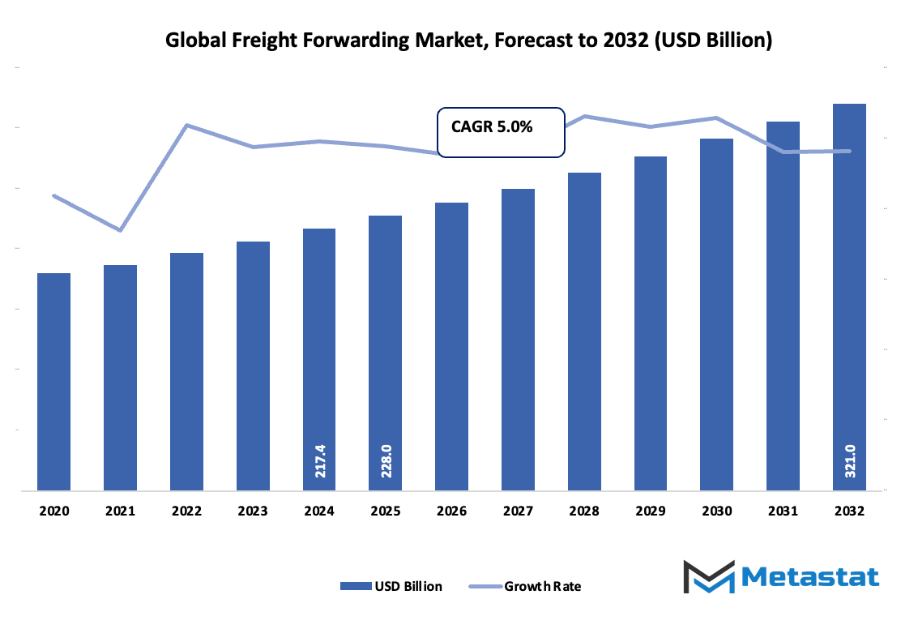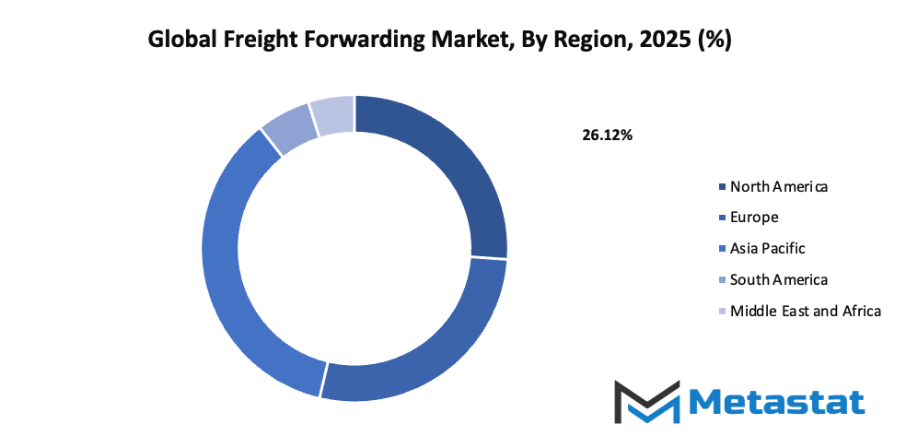Global Freight Forwarding Market - Comprehensive Data-Driven Market Analysis & Strategic Outlook
The global freight forwarding market was, and still is, a major part of the logistics industry, connecting continents and businesses long before digital systems start to control global trade. The market has existed since the early 19th century when small companies took care of the entire goods' transportation by handling the coordination between shipping lines, customs agents, and local carriers. All these intermediaries have been the ones to set up a network that was later on called a structured and strategic one, allowing trade on an international level to a scale never seen before.
- Global freight forwarding market was valued at roughly USD 228 million in 2025 and is projected to grow at a CAGR of around 5.0% through 2032, potentially surpassing USD 321 million.
- Ocean Freight Forwarding commands a share of about 56.9% of the total market, pushing the sector forward, and broadening its applications through intense research.
- The main factors behind the growth are: the increase in global trade and e-commerce, the need for effective and dependable supply chain solutions.
- Adoption of digital platforms and automated logistics solutions for increased efficiency are among the opportunities.
- The big picture: the market is going to grow by leaps and bounds in terms of value during the next decade, thus indicating enormous growth opportunities.

With the spread of industrialization, freight forwarding started to change its face. One of the most significant points was the arrival of containerization in the middle of the 20th century, which had a huge impact on the business forwarding. Using the standard containers, the cargo was moving between the ships, trucks, and trains without any problem, which reduced the time and cost of handling quite a lot. The change that took place not only improved the efficiency of the process but also gave rise to the development of global supply chains that were very reliant on accurate and timely forecasts and coordination this has been the very essence of the global freight forwarding market from the beginning and still is.
At the end of the 20th century, another big change came over the industry as technology was introduced. Digital tracking, automated documentation, and first-data-sharing platforms began to make an impact on the way shipments were handled. A business that was once heavily dependent on paper started shifting towards software-based solutions, which increased the level of transparency and accuracy. The internet era contributed significantly to the same and even made it possible for freight forwarders to run their routes, costs, and customs processes live.
User requirements have been a major factor in changing the market's character. The exposure of e-commerce forced the logistics people to have small deliveries done quickly and in the most efficient manner. Quickness, reliability, and transparency were the must-haves, which led many freight forwarders to the use of integrated logistics systems that united warehouses, ports, and fleets of transport under one digital roof. The changes in regulations between nations have cast a long shadow over the market. Free trade agreements, eco-friendly standards, and security procedures have all contributed to the companies becoming more flexible and compliant with global regulations.
Market Segments
The global freight forwarding market is mainly classified based on Mode of Transportation, Customer Type, Service, Application .
By Mode of Transportation is further segmented into:
- Ocean Freight Forwarding: Ocean Freight Forwarding is a major contributor to the global freight forwarding market by being the most reliable and economical method of shipping large quantities of goods to various countries. It links trade between nations by sea, thus facilitating the flow of products among different sectors in a timely and trustworthy manner.
- Air Freight Forwarding: Air Freight Forwarding is a great support for fast and secure exportation of goods over distances and is thus a perfect mode for time-sensitive and high-value shipments. The global market of Freight Forwarding gains from this air transport as it provides quickness and assurance to industries that need prompt delivery, like healthcare, electronics, and retail, which are the main ones, among others.
- Road Freight Forwarding: Road Freight Forwarding has a significant impact on the market as it facilitates both domestic and international transportation of goods. It can reach the end users without passing through sea or air thus increasing its route options and providing the flexibility, convenience, and door-to-door service that is often required in short and medium distance logistics.
- Rail Freight Forwarding: Rail Freight Forwarding is the most eco-friendly and efficient way for bulk goods to be transported on land. A cost-effective movement of heavy goods and materials is supported by this mode within the market often used by the manufacturing, mining, and energy industries which can already be seen in these sectors due to safe and trustworthy carrying of large loads.
By Customer Type the market is divided into:
- B2B: The B2B services in the global freight forwarding market are aimed at business-to-business dealings, where companies deal with large shipments and have complex logistics needs. Thus, these services bring about supply chain management that is both efficient and fast, and also reduce transportation costs for industries that need to move large quantities of goods from one region to another.
- B2C: B2C transactions in the market are directed to business-to-consumer dealings and the rapidly expanding e-commerce sector is one of the main beneficiaries. The services provided here are the very embodiment of speed, flexibility, and precision in the last-mile delivery process, thereby, playing a major role in the customer satisfaction and delivery experience enhancement.
By Service the market is further divided into:
- Transportation & Warehousing: Transportation & Warehousing stand at the very heart of the market, delivering complete logistics solutions. In fact, these services not only guarantee the secure storage of goods, but also their quick transport and smooth handling of the whole inventory. As a result, the conjunction of these services plays an important role in facilitating international trade by making sure goods are moving from their source to their point of sale without interruption.
- Value-added Services: Value-added Services play an essential part in the market and at the same time increase the cost of operations by including customs clearance, cargo tracking, and documentation support. The combination of these services allows businesses to make their supply chains more efficient, thus, cutting down on delays and facilitating faster shipments, which in turn, leads to greater customer satisfaction.
- Packaging: One of the major factors that affect the market is the developing of the packaging process of the products, which is, in fact, the main reason why the goods do not get damaged and are delivered together with all their components and up to the customer's satisfaction. Moreover, adequate packaging prevents products from getting spoiled, supports the meeting of legal requirements, and ensures the quality of products over large distances, thus, contributing to the reliability of the delivery.
- Others: The global freight forwarding market has also various other services such as consultancy, insurance, and order management. The latter are the ones that help international trade through risk minimization, compliance assurance, and providing personalized innovative solutions that suit different sectors' specific transportation and logistics needs.
By Application the global freight forwarding market is divided as:
- Retail & E-commerce: The Retail & E-commerce sectors have been one of the major reasons the global freight forwarding market has witnessed strong demand. This is mainly because of the need for fast and flexible delivery networks. Freight forwarding helps in the timely availability of products, efficient management of inventories, and international trade thereby making it easy for the different businesses to access customers around the world effectively.
- Healthcare: The healthcare sector is one of the main customers of the market that provides the secure and timely delivery of medical supplies, pharmaceuticals, and equipment. The temperature control and compliance with the regulations that are in place for the handling of the products throughout the freight process, ensure safety and quality, thus, making this sensitive industry rely on freight forwarding as one of its key support processes.
- Food & Beverages: Logistics for Food & Beverages in the market are all about the quality of the product and the delivery on time along with the safety factor. The proper storage and transportation with the required temperature control aim at maintaining the product quality. The reliable freight forwarding service makes it possible to supply the markets constantly while at the same time com
- Media & Entertainment: The Media & Entertainment industries are one of the users of the market that rely on the safe transport of equipment, promotional materials, and event-related goods. The segment depends on the factors like efficiency, accuracy, and flexibility to be able to guarantee timely setup and smooth operations for production and promotional activities all over the world.
- Industrial & Manufacturing: The Industrial & Manufacturing sectors are the ones that take advantage of the market to transport raw materials, machinery, and finished products between countries. The reliability of the transportation system helps the factories to keep their production schedules, thus, reducing the downtime, and overall increasing the operational efficiency by making sure of the uninterrupted flow of materials.
- Oil & Gas: Oil & Gas industries depend on the market for transporting heavy equipment, pipelines, and spare parts to remote and offshore locations. The focus remains on safety, timely delivery, and cost efficiency, supporting exploration, production, and maintenance activities effectively.
- Others: Other applications in the global freight forwarding market include construction, defense, and agriculture. These sectors rely on freight forwarding for specialized logistics services that ensure secure, timely, and cost-effective transportation of diverse goods across regions and industries.
|
Forecast Period |
2025-2032 |
|
Market Size in 2025 |
$228 Million |
|
Market Size by 2032 |
$321 Million |
|
Growth Rate from 2025 to 2032 |
5.0% |
|
Base Year |
2024 |
|
Regions Covered |
North America, Europe, Asia-Pacific, South America, Middle East & Africa |
By Region:
- Based on geography, the global freight forwarding market is divided into North America, Europe, Asia-Pacific, South America, and the Middle East & Africa.
- North America is further divided into the U.S., Canada, and Mexico, whereas Europe consists of the UK, Germany, France, Italy, and the Rest of Europe.
- Asia-Pacific is segmented into India, China, Japan, South Korea, and the Rest of Asia-Pacific.
- The South America region includes Brazil, Argentina, and the Rest of South America, while the Middle East & Africa is categorized into GCC Countries, Egypt, South Africa, and the Rest of the Middle East & Africa.

Growth Drivers
- Growth in global trade and e-commerce: The expansion of international trade and rapid growth of online retail have created strong demand for freight forwarding services across borders. Businesses require faster and more reliable delivery networks to meet customer expectations. The increasing movement of goods between countries continues to strengthen the global freight forwarding market and fuel its overall growth.
- Demand for efficient and reliable supply chain solutions: The need for smooth and dependable logistics operations has become essential for companies managing global shipments. Businesses seek service providers that can ensure timely transportation, proper documentation, and real-time tracking. This growing preference for efficiency and reliability is a major factor driving the development of the market.
Challenges and Opportunities
- Regulatory complexities and customs compliance challenges: Freight forwarding companies face continuous hurdles due to varying international trade laws and customs procedures. Strict documentation rules, tariff changes, and inspection delays can slow down shipping operations. Managing these diverse requirements increases workload and affects operational efficiency within the global freight forwarding market.
- High operational costs and fuel price fluctuations: Rising fuel expenses and maintenance costs create uncertainty for freight forwarding businesses. These factors directly affect pricing strategies and profit margins, making cost control a constant challenge. Fluctuating fuel rates can disrupt budgeting and limit competitiveness in the global freight forwarding market.
Opportunities
- Adoption of digital platforms and automated logistics solutions for enhanced efficiency: The integration of technology such as automated tracking, artificial intelligence, and online booking systems is improving productivity and transparency. Digital platforms simplify route planning, inventory management, and customer communication. These advancements create opportunities for better performance and competitiveness in the global freight forwarding market
Competitive Landscape & Strategic Insights
The global freight forwarding market continues to expand as trade and logistics become more interconnected across regions. The movement of goods across borders has become a vital part of global commerce, helping businesses reach wider markets and ensuring the smooth flow of supply chains. Companies in this market play a major role in connecting manufacturers, suppliers, and consumers by managing the transportation and coordination of goods through land, air, and sea routes. Their operations involve organizing shipments, handling customs procedures, and providing logistics solutions that improve delivery speed and efficiency.
The industry is a mix of both international industry leaders and emerging regional competitors. Important competitors include DHL Global Forwarding, DB Schenker, Kuehne + Nagel, DSV Panalpina, Expeditors International, Sinotrans, Kerry Logistics, CJ Logistics, Nippon Express, Agility Logistics, Hellmann Worldwide Logistics, Bolloré Logistics, CEVA Logistics, Yusen Logistics, Geodis, ITL Corporation (Inter Logistics), Rhenus Logistics, T&M Forwarding, Dachser, and DB Group (Dimerco) in market. These companies have built their reputations through consistent service quality, innovation in logistics solutions, and strong global networks. While some focus on international freight operations, others have strengthened their presence in specific regions, addressing the growing demand for regional trade support.
Growing digital transformation in logistics has changed how freight forwarding companies operate. Advanced tracking systems, automation, and data management tools have allowed more accurate shipment monitoring and improved transparency for clients. Many companies now use digital platforms that give real-time updates, enabling businesses to manage their supply chains more efficiently. This digital shift has also encouraged competition, as both large and regional players try to offer faster, more reliable, and cost-effective services.
Sustainability has become another key focus across the market. Logistics companies are working to reduce carbon emissions and improve energy efficiency through greener transportation options and better route planning. Such efforts not only help the environment but also attract businesses that value responsible and sustainable operations. With governments introducing stricter environmental regulations, companies are also investing in alternative fuels, electric vehicles, and eco-friendly packaging.
Market size is forecast to rise from USD 228 million in 2025 to over USD 321 million by 2032. Freight Forwarding will maintain dominance but face growing competition from emerging formats.
The global freight forwarding market continues to grow with increasing international trade, e-commerce, and the need for dependable supply chain management. Although challenges such as changing regulations, fuel price fluctuations, and geopolitical tensions affect operations, companies continue to adapt through innovation and partnership. With competition between global leaders and regional firms, the market will keep evolving, focusing on speed, sustainability, and customer satisfaction.
Report Coverage
This research report categorizes the global freight forwarding market based on various segments and regions, forecasts revenue growth, and analyzes trends in each submarket. The report analyses the key growth drivers, opportunities, and challenges influencing the global freight forwarding market. Recent market developments and competitive strategies such as expansion, type launch, development, partnership, merger, and acquisition have been included to draw the competitive landscape in the market. The report strategically identifies and profiles the key market players and analyses their core competencies in each sub-segment of the global freight forwarding market.
Freight Forwarding Market Key Segments:
By Mode of Transportation
- Ocean Freight Forwarding
- Air Freight Forwarding
- Road Freight Forwarding
- Rail Freight Forwarding
By Customer Type
- B2B
- B2C
By Service
- Transportation & Warehousing
- Value-added Services
- Packaging
- Others
By Application
- Retail & E-commerce
- Healthcare
- Food & Beverages
- Media & Entertainment
- Industrial & Manufacturing
- Oil & Gas
- Others
Key Global Freight Forwarding Industry Players
- DHL Global Forwarding
- DB Schenker
- Kuehne + Nagel
- DSV Panalpina
- Expeditors International
- Sinotrans
- Kerry Logistics
- CJ Logistics
- Nippon Express
- Agility Logistics
- Hellmann Worldwide Logistics
- Bolloré Logistics
- CEVA Logistics
- Yusen Logistics
- Geodis
- ITL Corporation (Inter Logistics)
- Rhenus Logistics
- T&M Forwarding
- Dachser
- DB Group (Dimerco)
WHAT REPORT PROVIDES
- Full in-depth analysis of the parent Industry
- Important changes in market and its dynamics
- Segmentation details of the market
- Former, on-going, and projected market analysis in terms of volume and value
- Assessment of niche industry developments
- Market share analysis
- Key strategies of major players
- Emerging segments and regional growth potential








 US: +1 3023308252
US: +1 3023308252






